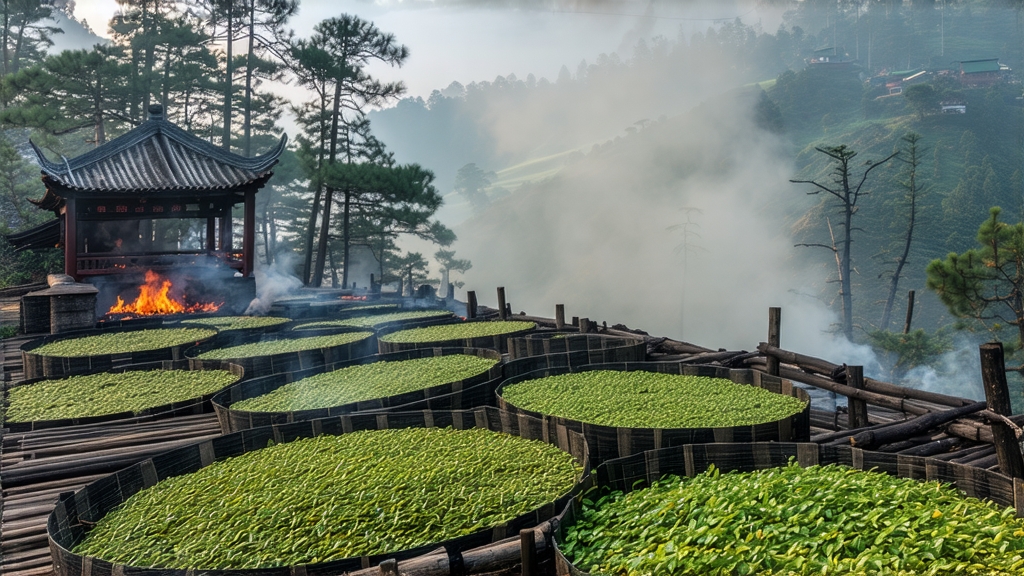
When European tea drinkers first encountered the dark, twisted leaves that produced a liquor the color of burgundy and a scent reminiscent of campfire and dried longan, they did not know they were tasting the primordial form of all black tea. That tea was Lapsang Souchong, a name that still carries the echo of seventeenth-century Cantonese merchants who labeled it “small sort from Lapu mountain.” Grown inside the granite gorges of the Wuyi massif in China’s Fujian province, this smoke-kissed tea has outlived dynasties, inspired伯爵红茶 (Earl Grey prototypes), and today enjoys a cult following among whisky blenders and specialty-bar baristas. To understand Lapsang Souchong is to hold a living ledger of global trade, Chinese craft, and evolving palate preferences in one’s cup.
Historical Footprints
The earliest written record appears in 1646, when a Jiangxi merchant named Zhang Wanqun noted that “Wuyi roasted leaves fetch twice the price of green at Xiamen port.” By 1669 the British East India Company had logged it as “bohea tea,” a corruption of “Wuyi,” and shipped 143 lb to London. The pine smoke that preserved the leaf during monsoon transport became its trademark; Victorian ladies even burned strips of Lapsang in silver pans to perfume drawing rooms. In the late nineteenth century, declining export demand pushed local farmers to invent the subtler “unsmoked” Zheng Shan Xiao Zhong, but the original campfire style survived in the village of Tongmu, now a protected geographical indication within a national nature reserve.
Micro-Terroir and Two Families
Lapsang Souchong belongs botanically to the Xiao Ye Zhong (small-leaf) cultivar group, thriving at 600–1,200 m on weathered tuff soils. Morning fog diffuses sunlight, forcing the bush to synthesize more L-theanine and volatile terpenes, precursors to both sweetness and smoke absorption. Within Tongmu there are two lineages:
- Traditional Smoke-Dried (Song Xing Zheng Shan): leaves wither over slow-burning Masson pine, absorb resin, then finish above embers in bamboo sieves.
- Modern “Wuny” or Fruity Style (Wu Nong Xiang): same leaf, but withering happens in electrically heated rooms; final charcoal bake is brief, emphasizing cocoa and dried-fruit notes rather than tarry smoke. Both qualify for EU MRL (maximum-residue-limit) certification because only pine wood, never pine needles or resinous bark, touches the leaf.
Crafting the Leaf: A 48-Hour Choreography
Picking begins at dawn during the short spring window when two leaves and a bud reach 3–4 cm. The pluck is flaccid within three hours, so bamboo baskets are lined with banana leaves to prevent bruising. Once back at the cottage, the leaves are spread 3 cm deep on rattan trays suspended in the loft above a ground-floor pine hearth. Smoke is generated by smoldering 40-year-old Masson pine logs whose sap has partially crystallized; the temperature stays below 32 °C so enzymatic oxidation can proceed. Every 20 minutes the farmer shuffles the trays, allowing an even deposition of guaiacol and syringol—the same phenols that later translate into whisky-like aromas.
After six hours the leaf has lost 60 % moisture and turns velvety; it is then rolled for 45 minutes on a cast-iron kneading table lined with hemp cloth. Oxidation follows in wooden chests lined with wet cotton; the leaf pile never exceeds 8 cm, and the temperature is kept at 24 °C by opening or closing the lid. Once the leaf acquires a coppery hue and the grassy note vanishes, the firing stage begins: woven bamboo sieves are placed 70 cm above glowing pine coals for 30 seconds, then removed to cool for two minutes; the cycle repeats eight times. Finally, the tea is “pine-resting” for one week in earthen jars sealed with rice paper, allowing smoke phenols to polymerize into softer, sweeter compounds.
Chemical Signature in the Cup
Gas-chromatography studies from the Wuyi University Tea Science Lab show that properly smoked Lapsang contains 3.2–4.5 mg kg⁻¹ guaiacol and 0.8–1.1 mg kg⁻¹ 4-methylguaiacol, levels comparable